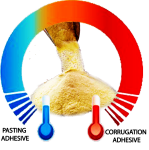If you’re a manufacturer of Corrugated Paperboard, warp as a concept wouldn’t be something you’d be unfamiliar with. Elimination of warp can at times be slightly tricky. This article will give an insight into the causes of warp and possible solutions to eliminate it.
Corrugated Paperboard becomes bent or is twisted out of shape, typically as an aftereffect of improper heat or moisture levels which eventually causes huge losses to businesses. Warp is one of the very common manufacturing issues faced by manufacturers worldwide which leads to excessive scrap generation, something that definitely is very unappealing.
Here’s a list of causes that can lead to warp with solutions that can help in eliminating it.
PROBLEMS THAT ARISE DUE TO INSUFFICIENT HEATING ON MACHINE ROLLS
- Low Heat on Pre-heater Rolls: Excessive moisture on the paper needs to be eliminated to avoid warp. If the preheating rolls do not function effectively, moisture from the kraft paper cannot be eliminated which can lead to warp.
Solution: Install a pre-heater roll and check if it is functioning properly. It is inevitable to have them functional in places with high humidity levels. Modern machines mostly have pre-heaters installed. So this will be a problem that arises if you have older machines.
- Low Heat on Pressure and / or Fluting Rolls: Improper heat on the fluting rolls not only affects the flutes of the paperboard but can lead to warp. With low heat on the rolls, the adhesive may not gelatinize properly which can lead to delamination and at the same time excess moisture due to non-gelatinization can lead to warp.
Solution: Maintain at least 180o C – 200o C on the rolls to ensure proper gelatinization. In-case of non-gelatinization, machine speed should be reduced to ensure that paper and glue get more heat. To eliminate warp, machine speed and temperature settings have to be adjusted accordingly to ensure that it gets just enough heat to gelatinize.
MOISTURE RELATED PROBLEMS DUE TO THE ADHESIVE WHICH IS USED
- Application of excessive adhesive: More adhesive means more moisture, which can cause the problem of warp to arise.
Solution: Adhesive should be consistently applied only to the flute tips. Reduce the glue setting on the machine to apply only the needed amount of adhesive to bind the different layers of paper together. If more adhesive is applied, not only the cost of manufacturing increases, but it can also cause warp.
- High Gel temperature of adhesive: If the gel temperature of the adhesive used is too high, the adhesive may fail to gelatinize leading to delamination and warp.
Solution: Reduce the machine speed to ensure more heat to the slow drying adhesive or use a fast drying adhesive with low gel temperature.
- Low viscosity of the adhesive: More water in adhesive means more dampness, which can lead to warp.
Solution: The adhesive should have appropriate solid contents to ensure proper bonding and the viscosity should be adjusted according to the paper used.
MOISTURE RELATED PROBLEMS DUE TO THE PAPER WHICH IS USED
- High Moisture level in paper: If the paper used has more moisture content, it can lead to warp.
Solution: Install pre-heaters to eliminate moisture from the paper.
- Absorption of Moisture by paperboard after manufacturing: This particularly is a problem faced in areas with high humidity. Paper being hygroscopic in nature can regain moisture during storage or transit.
Solution:
Two alternatives that can help in eliminating warp are enumerated below.
- One possible solution could be to change the top paper to reduce the surface area from which moisture can get absorbed. This alternative can be slightly costlier.
- Another possible solution, which is also cost effective and easy to be implemented is the use of low-alkaline and non-alkaline adhesive in the manufacturing process. Kraft Paper attracts moisture from the atmosphere. Similarly, highly alkaline adhesive with higher pH values also attract moisture from the atmosphere. This traditional combination of highly alkaline adhesive with kraft paper causes moisture problems. Low-alkaline and non-alkaline adhesive can help in resisting absorption of atmospheric moisture. Pre-mix Moisture resistant adhesives are available, which can save the hassles of storing and adding different chemicals.
TENSION DUE TO MISALIGNMENT OF MACHINE ROLLS AND COMPONENTS
To avoid paper stresses, tension stresses and wrinkles on the paper
- Ensure bearings and rolls are freely moving to avoid tension stress.
- Ensure that all bearings and rolls are adjusted to effectively pull the paper without creating any wrinkles or folds or paper stresses.
- Ensure all components and rolls are adjusted to function parallel
Warp has always been one of the common problems faced by corrugated carton manufacturers worldwide. Hiring an experienced operator and selecting the right raw materials can help in eliminating warp issues.
http://www.indianadhesive.com / www.sanjayadhesives.com






 Believe it or not – Moisture is the Invisible Culprit which affects the quality of Corrugated Boxes in all parts of the World. The quality deterioration is very much visible when you work with lower quality paper, while if you work with very high quality paper, you may always think that your quality is absolutely perfect, given the fact that you get no complaints from your customers. But the fact can be that your quality is far away from what it should have been with the combination of papers used.
Believe it or not – Moisture is the Invisible Culprit which affects the quality of Corrugated Boxes in all parts of the World. The quality deterioration is very much visible when you work with lower quality paper, while if you work with very high quality paper, you may always think that your quality is absolutely perfect, given the fact that you get no complaints from your customers. But the fact can be that your quality is far away from what it should have been with the combination of papers used.